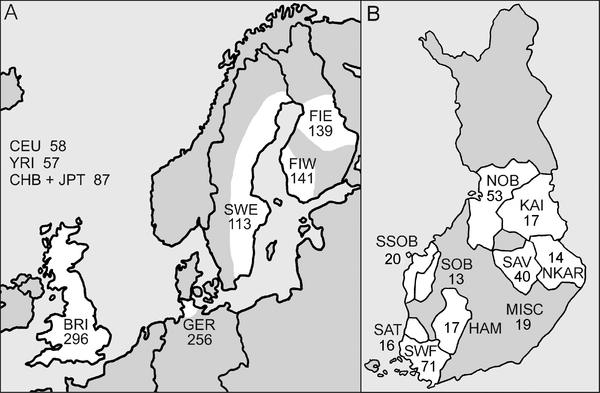A recent study shows that genetic differences in Central Europe appear smaller than between and even within North European populations. The study, led by researcher Päivi Lahermo from Institute for Molecular Medicine Finland (FIMM) and University of Helsinki, Finland, and professor Juha Kere from Karolinska Institutet, Sweden.
The understanding of genetic variation in human populations is important not only for obtaining information on population history, but also for successful studies of genetic factors behind human diseases, says Juha Kere.

The map of Northern Europe (a) and Finland (b), and the sample sizes. The studied (sub)populations and their geographical ranges are shown in white. Abbreviations for the populations: Western Finland (FIW); Eastern Finland (FIE); Sweden (SWE); Germany (GER); Great Britain (BRI); Utah residents with ancestry from northern and western Europe (CEU); Yoruba from Ibadan, Nigeria (YRI); Han Chinese from Beijing, China (CHB); and Japanese from Tokyo, Japan (JPT). Abbreviations within Finland: Southwest Finland (SWF); Satakunta (SAT); Häme (HAM); Southern Ostrobothnia (SOB); Swedish-speaking Ostrobothnia (SSOB); Savo (SAV); Northern Karelia (NKAR); Kainuu (KAI); Northern Ostrobothnia (NOB); Miscellaneous (MISC).
Human population genetic studies have recently gained a new powerful tool from the analysis of densely spaced single nucleotide polymorphisms (SNPs) across the whole genome. In this study, almost 250 000 such polymorphisms were used to analyze genetic differences between the Germans, British, Eastern and Western Finns, and Swedes, based on ca. 1000 samples.
The genetic difference between Eastern and Western Finland is substantial in a European scale, and there are also clear differences between Finnish counties. The larger genetic distances in the north are caused by differences in population history, they write. The northernmost parts of Europe were inhabited later than Central Europe and by fewer people, and have had smaller populations since then, says Päivi Lahermo.
Citation: Salmela E, Lappalainen T, Fransson I, Andersen PM, Dahlman-Wright K, et al. (2008) Genome-Wide Analysis of Single Nucleotide Polymorphisms Uncovers Population Structure in Northern Europe. PLoS ONE 3(10): e3519. doi:10.1371/journal.pone.0003519






Comments